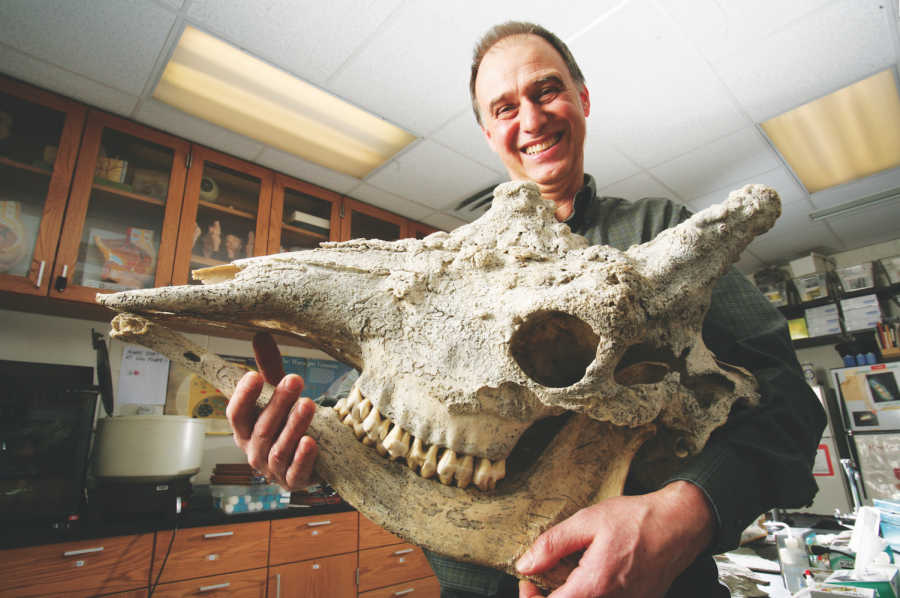Guy Robinson Ph.D., Fordham’s Resident Pollen Analyst
November 14, 2018
Fordham College at Lincoln Center (FCLC) biology professor Guy Robinson, Ph.D., is making great strides with his pollen analysis research. His research focuses on palynology, the study of pollen grains found in geographical deposits.
The main focus of one of his many palynology research studies is analyzing fossil pollen. To do this, Robinson and his team take sediment cores out of lakes and bogs in southern New York state from different macro and microfossils that were left buried in mud for tens of thousands of years.
What’s special about this is that the mud from different wetlands such as lakes and bogs have layers. The deeper you dig, the farther back in time you go. When you separate and carbon-date these layers, you can get an idea of which time period the pollen grains were entrapped. By identifying the type of pollen grain it is, you can determine the type of tree it came from. Robinson emphasized the importance of determining the abundance of each pollen grain because it gives one an idea about the sedimentation rates, which indicates how fast certain geographical landscapes were shaped and provides a vision of what the world in that time period looked like. Knowing the proportions of pollen at a given time, one can infer what kinds of trees, plants and flowers were growing at a given period.
Robinson noted that there were limitations to using palynology to determine the features of the land. He said that not all plants produce a lot of pollen, especially those pollinated by animals and insects. Despite these limitations, “pollen analysis can still provide us with a great deal of understanding about the density of plants in certain landscapes,” said Robinson.
Pollen analysis can also provide us with an idea of the increase or decrease of plant and tree types through the millennia. For example, during the Ice Age, spruce trees could be found in abundance in North-Eastern America. If you were to pick up a sample of mud from 10 thousand years ago, you would find a lot of spruce pollen grains. However, if you compared this amount to how plentiful spruce pollen grains are today within the same region, you would find a huge decrease. Robinson explained that the number one factor behind this trend is the climate change that occurred thousands of years ago. He said “massive ice sheets came all the way down to Prospect Park in Brooklyn 20 thousand years ago.” When the global temperature increased, spruce trees were no longer prolific in this region because they are predominately found in cooler temperatures. Now, they are most prevalent in regions like Northern Canada, where it is cooler.
There are modern applications of pollen analysis as well. Fordham University has two stations from where Robinson and his team can regularly track the pollen count. One is at the FCLC campus and the other is in a biological research center in Armonk, N.Y. Pollen traps are installed in these stations to take samples of the particles in the air. The pollen traps have wind vanes on them that point to the direction that the wind is coming from. Underneath the airfoil of the apparatus, there is a narrow opening where an electric motor sits and pulls in air. Once the air travels past the opening, it is intercepted by a drum attached with tape that turns every seven days. This tape can be removed and cut into seven pieces, each displaying the pollen count for the day. After the team counts the pollen grains under a microscope on each slide, they record their findings in the Fordham Pollen Index and take photos of the different types of pollen found.
The Fordham Pollen Index tracks the pollen count in New York City weekly in the spring and monthly during the other seasons. The pollen records we have can date back 10 years and if we count the station in Armonk the records date back 20 years.
Public health research can also be enhanced with pollen analysis. By tracking the pollen count in the air by taking air samples and knowing the type of pollen grains that are the most abundant, we can make inferences on how it will affect individuals with allergies. In a 2011 research report for the Center for Disease Control and Prevention, Robinson found that because of the increased pollen count there would be an increase in allergy medication sales. The rise in sales could be attributed to a surplus in the allergenic pollen deposits of trees such as birch, oak and sycamore.
The size of a pollen grain is microscopic, but studying these small molecules can lead to big discoveries. Scholars in the scientific field are optimistic that they will reach new scientific feats with further pollen analysis studies.














